

Enemy TanksRuben Urribarres |
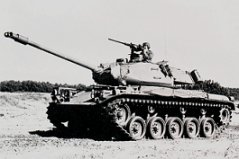 In
1949 the Cadillac firm built this light tank by specification of the US Army,
for the recognition battalions of their armored and cavalry units, that must they
must had somewhat capable of defeating the soviets T-34-85. But for the
moment in which was created the M41, appears the T-54. The Cadillac built 5,500
M41 for the US Army and its allies, until the end of the production in 1959.
In
1949 the Cadillac firm built this light tank by specification of the US Army,
for the recognition battalions of their armored and cavalry units, that must they
must had somewhat capable of defeating the soviets T-34-85. But for the
moment in which was created the M41, appears the T-54. The Cadillac built 5,500
M41 for the US Army and its allies, until the end of the production in 1959.
Five tanks of this type formed the 4° Tank Battalion of the 2506 Brigade
of Cuban exiled, that disembarks in Bay of Pigs on April 17, 1961. The
M41 landed since barges LCU by Giron. They intensely fought, supporting
the infantry, achieving to defeat 5 T-34-85, together the recoilless rifles and
the bazookes, until they were defeated, losing 2 destroyed and the remainder damaged
or abandoned without munitions. Cuba send one M41 to the USSR, that was studied
for the soviets, and that today is exhibited in the Kubinka Museum of Moscou.
Another are exibited in the Museum of Giron Beach.
| Built: 1949 Armor: turre 25-38 mm, hull 19-31 mm Dimensions: lenght 8080 mm, height 2850 mm, width 3264 mm Armament: One 76mm Gun M32, a 12,7mm machine gun M2 and one 7,62mm Browning M1919A4E1 | Crew: 4 man Weight: 23,500 kg Speed: 72 km/h Road ratius: 240 km |
 | Exiled tanker dead over its M41 destroyed in Bay of Pigs. To its side march a column of militiamen toward the front (Photo from Juan Carlos Rodríguez, "La batalla inevitable") |
 | One of the 5 tanks M41 of the 2506 Brigade that landed in Bay of Pigs, are exhibited today in the Girón Beach Museum |
![]() Olifant Mk.I (South African SADF in Angola)
Olifant Mk.I (South African SADF in Angola) 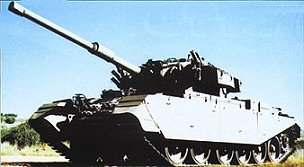 In
1957 South Africa acquires some 250 tanks A41 Centurion Mk. 3 and Mk. 5 in Great
Britain, that constituted the base of their armored forces. But the apparition
of the better Cubans T-55 in Angola in 1976, and the possible collision with them,
forced to the South African command to begin its modernization in 1977, with the
Israeli aid. Then is installed a more powerful motor, a 105mm British canon L7A1,
and others modifications, receiving the new name of Olifant Mk.IA.
These modifications enlarge its weight until 53 t, which difficult their participation
in numerous operations, in spite of that its armor not was improved. In comparison,
the Cuban-Angolans T-55 and T-62
(36,5 and 37,5 t), participated more intensive all the War.
In
1957 South Africa acquires some 250 tanks A41 Centurion Mk. 3 and Mk. 5 in Great
Britain, that constituted the base of their armored forces. But the apparition
of the better Cubans T-55 in Angola in 1976, and the possible collision with them,
forced to the South African command to begin its modernization in 1977, with the
Israeli aid. Then is installed a more powerful motor, a 105mm British canon L7A1,
and others modifications, receiving the new name of Olifant Mk.IA.
These modifications enlarge its weight until 53 t, which difficult their participation
in numerous operations, in spite of that its armor not was improved. In comparison,
the Cuban-Angolans T-55 and T-62
(36,5 and 37,5 t), participated more intensive all the War.
But to the end of the 1987 year, South Africa is implied in a full intervention in the Angolan War of Angola, and the Olifants are sends to combat, participating with success against the Angolans forces near the Lomba River. On September were the first Tanks combats in this War, between the Angolans T-55 and the Olifants. The South African SADF then advances toward to the strategic point of Cuito Cuanavale to take it, and the Angolans ask urgent aid by the Cuban troops.
The first great attack to Cuito Cuanavale was performed by the SADF and the UNITA on January 13, 1988. That day the weather was storming, with strongs rains, and the South African thought that the MiGs not would flying. Therefore they were grouped in open field to perform a second attack in the afternoon, without camouflage and in narrow formations. This error was heavy pay. The weather improves slightly, and immediately take off from Menongue the Cubans MiG-21bis and MiG-23ML, with 1 ton of bombs each one. They surprise the SADF group and cause it heavy loses, destroying numerous equipment. To take advantage of the occasion the MiGs take off again twice, this time with 2 tons of bombs each one, and escorted by 4 MiG-23ML with missiles R-24 and R-60. In total they do there 22 missions, beat the SADF with 32 tons of bombs, with the loses of various Olifants, armored cars Elands, and other vehicles. Then the SADF desists of the attack to Cuito that day, and retires of the zone for replace its forces, losing in that intent 7 Olifants by the artillery fire, the T-55 and the MiG-21bis and MiG-23ML attack.
On February 14, 1988 the SADF and the UNITA begin the second heavy attack to the Cuito Cuanavale defenses, with forces sized in three SADF and six UNITA battalions, supported by more of 100 armored vehicles of various types, among them 40 Olifants Tanks. By this superiority of forces, they achieve to break the defense of the 59° Angolan Brigade. To cover this place were urgently thrown the unique 8 T-55 Cubans in movement in Cuito, by the command of the lieutenant colonel Héctor Aguilar. They stop the South African, destroying 10 Olifants and 4 armored cars, and losing 6 T-55 (3 by anti-tanks rockets RPG, and 3 by the Olifants). The remainder of the Olifants retires behind march. In this collision die 14 of the 39 Cubans perished in the battle of Cuito Cuanavale, but this sacrifice went not in vain, therefore the attack of its T-55 saves the situation of the battle, that already was in crisis. This is the first collision in the war between Olifants and Cubans T-55, and is a victory for these, which would be the norm until the end of the war. March 23 the Olifants support the last attack to Cuito Cuanavale, that finishes with another disaster, when the SADF lost 3 Olifants in minefields and by artillery fire.
The Olifants can neither impede the Cuban offensive toward the Namibian border, being defeated in each collision. June 27, 1988 are produced the last combats, near the border in the zones of Calueque, Donguena and Tchipa, where the SADF is defeated, abandoning armored, dead soldiers and a sergeant prisoner, and they are expelled to Namibia. The same day the Cubans MiG-23 destroy their forces by Calueque. Then South Africa does not resist more, and was forced to asks the peace to Cuba. Some South African sources admit the lost of at least 20 Olifants during their year of operations in Angola (1987-88). However, in reality in only four attacks to Cuito Cuanavale the SADF lost some Olifants, althought the majority of the occasions the South African achieved to evacuate their Tanks, to repair them or for parts.
The Olifants Mk.1A were qualified as "enormous" and "noisy' by the Cubans,
they were Tanks of easy detection and bad mobility, but with good fire power and
medium armor protection (lower to the protection of the T-55 and T-62). By their
characteristics, were lower to the T-62 of the Cuban
troops, so much in protection, as mobility, fire power, and fire control systems,
but continued being a strong enemy. This obsolet tank instead today in service
in South Africa, where remain only 154 Olifants.
| Built: 1945 (modernized 1977) Dimensions: lenght 9830 mm, height 2940 mm, width 3390 mm Armor: turret 51-152 mm, hull 51-76 mm Armament: One 105mm gun L7A1, two 7,62 mm machine guns | Crew:
4 man Weight: 53,000 kg Speed: 45 km/h Road ratius:: 250 km |
 | One of the Olifants destroyed and captured in Cuito Cuanavale in February- March of 1988, after the disastrous intents of the SADF to taking the locality (Photo from "La guerra de Angola") |
![]() Eland (South African SADF in Angola)
Eland (South African SADF in Angola) 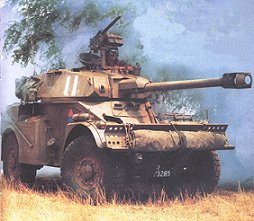 This
South African Armored Car extensive participated in the Angolan War. In
1964 South Africa buys to France the license to produce his excellent Armored
Car Panhard AML, and the South African organization ARMSCOR organize his manufacturing
in the factories of the Sandock-Austral Beperk Limited of Boksburg, Transvaal,
with the new name of Eland. 1,600 were built in several versions, with the same
chassis, but used Hispanic-Suiza turrets, with different armament.
This
South African Armored Car extensive participated in the Angolan War. In
1964 South Africa buys to France the license to produce his excellent Armored
Car Panhard AML, and the South African organization ARMSCOR organize his manufacturing
in the factories of the Sandock-Austral Beperk Limited of Boksburg, Transvaal,
with the new name of Eland. 1,600 were built in several versions, with the same
chassis, but used Hispanic-Suiza turrets, with different armament.
When the South African SADF invade Angola during the "Operation Savannah" with 10,000 men in October 14, 1975 in two directions, they were extensively supported by the Eland. In November they already were at the doors of the capital Luanda. But in November 8 begin to arrive the Cuban troops, enforced little after with tanks T-34-85 and T-55, artillery and aviation, they stop the SADF and defeat it in various collisions, until they were totally expelled from Angola. Then in the border with Namibia, April 1, 1976 the South African governor of Namibia, the General Ewefp, firm the peace with the Cuban major Leopoldo Cintra Frias (future hero of the final campaign of 1988, see Cuito Cuanavale and Olifant). Numerous Eland were lost by the SADF in this campaign, by its impotence before the heavy equipment, the excellent tactical preparation, and high morale of the Cubans.
Only in the battle
by Ebo in November 23, the SADF and the UNITA suffer the lost of 76 dead, 8 destroyed
Elands by the RPG-7 and 75mm recoilless rifles Grad P, and lost other equipment,
in spite of their 3 times numerical superiority. This combat was qualified by
the South Africans as the "Black Sunday". As results of this campaign,
the SADF avoided in the future the direct encounters with the Cubans, and prefer
to be faced to the Angolan FAPLA. The Eland is a good equipment for the fight
against light forces, but not apt against strong enemies. Form there 1,600 built
Elands, today remain in service only 146.
| Built: 1959 Dimensions: lenght 3790 mm, height 2700 mm, width 1970 mm Armor: 15 mm Armament: One 90mm gun Giat F1 (or 60 mm mortar or two 7,62mm machine guns) and two 7,62 mm Browning machine guns | Crew: 3 hombres Weight: 5,500 kg Speed: 100 km/h Road ratius: 600 km |
 |
 |
 |
 |
 |
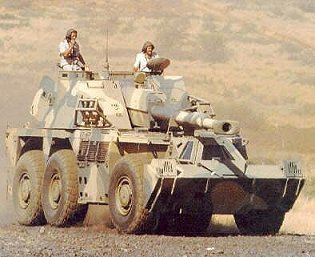 This
was one of most important weapons systems in the Angolan War. These famous 155
mm howitzers were designed by the Canadian engineer Bull of the Space Research
Corporation, by the requirements of the South African ARMSCOR, and were considered
between the better of the world, with its 39 km range and great precision. Weigh
13,750 kg and made 4 shots by minute. Began be project in 1975, and in the eighties
begins to be manufactured by the South African firm Lyttelton Engineering Works
(LEW). To enlarge its mobility is manufactured the self-propelled version
G6 Rhino in the 6 x 6 chassis of the Armored Vehicle Ratel,
that weighs 46 t and enters in service in 1988. Each battery of G5/G6 had 8 howitzers,
and three batteries formed a regiment.
This
was one of most important weapons systems in the Angolan War. These famous 155
mm howitzers were designed by the Canadian engineer Bull of the Space Research
Corporation, by the requirements of the South African ARMSCOR, and were considered
between the better of the world, with its 39 km range and great precision. Weigh
13,750 kg and made 4 shots by minute. Began be project in 1975, and in the eighties
begins to be manufactured by the South African firm Lyttelton Engineering Works
(LEW). To enlarge its mobility is manufactured the self-propelled version
G6 Rhino in the 6 x 6 chassis of the Armored Vehicle Ratel,
that weighs 46 t and enters in service in 1988. Each battery of G5/G6 had 8 howitzers,
and three batteries formed a regiment. Participate by first time in combat
in 1985 in Angola. Later are intensively used during the last campaign of the
War, in the SADF operations "Moduler" and "Hooper".
On August 17, 1987 the first G5 battery begins to fight against the FAPLA in the
combats near the Lomba River. On October 15 begin the attack of the Cuito
Cuanavale zone, that is maintained by months, throwing these months sometimes
until 200 proyectiles daily. During the last intent of taking Cuito Cuanavale
on March 23, 1988, the G5 shoot 700 proyectiles against their defenders. To this
battle are thrown the recently manufactured self-propelled G6.
For the fire correction are used too small airplanes or planes without pilot Seeker RPV. On 3 September of 1987 by the Lomba River a SA-8 missile of the 21° Angolan Brigade shoot down the Bosbok airplane of the Lieutenant Richard Glynn, with the best South African fire corrector of the G5 and G6, killing to both. At least four airplanes without pilot RVP, were shoot down.
In February of 1988 begins the hunt to the G5
and G6 near the Cuito Cuanavale zone.
Previously the MiG-23ML take off to attack these howitzers, being guided by the
operating information of the Angolan or Russian. But this information frequently
was inexact, or delayed, and they not found them. The South African were very
well camouflaged, and stopped to shooting when detected the take off of the MiG-23,
besides that also they all the time changed their position. Then the Cuban Aviation
command organizes their own source of information, surfing the zone with pairs
of MiG-23ML, that should call the strike groups of MiG-23. On February the Colonel
Trujillo detects a G5 howitzer by the river Chambinga, and in low level flight
he throws it bombs with parashootes, and then arrive the others MiG-23, that destroy
the piece. That was the first G5 destroyed. On February 21 the Colonel Trujillo
with the Colonel Luis Alonso Reina organizes the air reconnaisance against the
G5. Since then the South African are more careful, they retire the pieces to the
maximum reach of their pieces (diminishing the accuracy), and almost every day
when the MiGs flying, the G5 stop shooting, by the frequent attacks of the MiG-23.
Since then the howitzers are in good measurement neutralized by the MiG-23ML strikes,
and they pass to be victims.
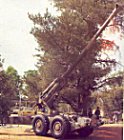 |
A G6 Rhino
howitzer shoot, and other elevate to 75° (Courtesy of Anton Dyason and Diego
Zampini) |
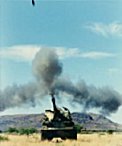 |
 |
The South African veterans remember:
Chapter
7 - Psychology debriefing team - Debrefing soldiers involved in Operation Hooper
1988.
"Migs were the big problem in Angola. We had nothing
to use against them, so effectively FAPLA (supported by Cuba and Russia) had air
superiority. A G5 (Artillery) sergeant told me; `When the Migs are in the air,
the war stands still.' G5s and multiple rocket launchers had to be careful
firing on cloudless days because they would give their positions away, and the
Migs would come hunting them"
(Fowler, Barry. "Pro Patria" United
Kingdom, Sentinel Projects, 1995).
By the Cuban advance toward Namibia, the G5 are urgently removed from the Cuito Cuanavale zone, and send to the zone of Calueque, near the border. They try to attacking the Cuban troops the days 20, 24 and 26 of June of 1988. But then is produced the Cuban answer with the devastator strike to Calueque by the MiG-23ML, after which South Africa asks for the peace. In general these howitzers cause few loses with their fire, in spite of the fantastic South Africans "reports". Their main effect was psychological, forced the troop to covered in their sites, and to avoid the movements in open field, which already was an achievement. But as count the Cuito Cuanavale veterans, in few days they became accustomed to their fire. Today remain in South Africa in service 45 howitzers G5 and 43 G6.
|
|
|
|
|||





